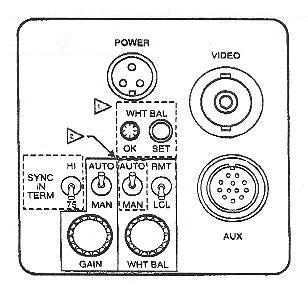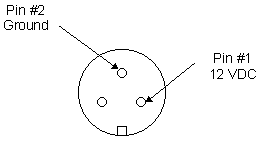https://www.cohu-cameras.com/
$1200-
Cohu wiring and features
(619) 277-6700
Simple connection
For simple setups, a pigtail adapter is available that only allows 12 volt power (4 pin XLR) and video out from to Cohu. For more sophisticated setups, the Cohu breakout box is used.
Sophisticated connection
To use the Colorado 440A frame buffer box with the Cohu camera, connect the composite out of the Cohu black box to the video in of the Colorado. Also connect the TO COHU connector of the Colorado to the integrate in of the Cohu black box. (The Colorado 446RGB box has simliar operation, but an RGB to Y/C converter is normally used (such as the Harmonic Research or Nova).
Also, the 446RGB does not have a gain booster, but the 440A does. When using the 446RGB, use the remote gain function of the Cohu.
Set the Colorado box to Operate and select the number of video frames to integrate over. Set the mode to field, not frame. If you want normal 30fps operation, set the Colorado box to MAN and Live.
The Integrate dial controls the number of VIDEO frames that the camera will integrate over. For example, if the knob is at 30, the Cohu will integrate for 30 video frames, which is a one second exposure with a 360 degree shutter blur. This will yield a wonderful five stop increase in brightness. There will be little increase in noise, except for stepper motor noise which will continue to integrate over the one second period.
The Cohu does not "fake" the integration. It is not thirty separate video frames added together, but rather the chip exposes for one full second, just like film.
Kuper and Cohu
If you are using the Kuper, you can synchronize the phasing.
You must use Kuper software dated July 14, 1996 or later, with the functional IC (integrating camera) command.
Get a cable from John Higbie that breaks out the DB15 of the Kuper into Cap Out, Flash Out and (optionally) video in. More recent designs buffer the Cap Out (GPI) signal so that multiple Perceptions can be triggered simultaneously.
The Flash Out goes to the Colorado box Integrate In (from Kuper) and controls the phase of the exposure. The Cap Out goes to the PAR or Perception GPI to fire it. If you are sending a GPI to multiple disc recorders (y-connector), you may need an active buffer box, not just a simple Y-connector.
Use the IC command. Do not use the FS command. The FS or IC parameters will overwrite one another. IC and FS parameters are not saved with the axes.set and must be re-entered whenever the Kuper is rebooted.
When using the IC during a preview, enter the shutter angle of the film camera, eg: 95 degrees to 265 degrees and the trigger length (70 milliseconds is good). The software will wait 1 millisecond and will then send out a GPI record pulse to the PAR/PVR.
If you want to record video while shooting film, set a shutter angle such as 0 degrees to 80 degrees and then the trigger width of 35 milliseconds (1/30th of a second). This will avoid the spinning mirror. The shutter angle could be set at 5 degrees to 355 degrees, but you will get two superimposed images, integrated during the part while the shutter was closed. Operation at 270 degrees to 90 degrees may be possible, not tested yet, but the image would be 180 degrees out of phase (only important during ultra critical rotoscoping).
Best results will occur if you set to Kuper to run at some derivative of 29.97fps. For example, don't run at 2 fps, run at 1.998fps. If you run at a non-NTSC speed, the video frames will get brighter, then darker as you move in and out of phase. Since there is no 3:2 pulldown, be sure to use the 24fps playback feature of the PAR/PVR for correct speed playback. The Amiga PAR 24fps playback (FILM mode) will only work properly with the BetaCam output of the PAR. Each PAR has a BetaCam/RGB monitor assigned to it. Perceptions don't require a special monitor for 24fps playback.
You can use the Kuper to send out a serial frame number to one PAR (with a background plate) and have another one record composites. You can use a Y-connector or switcher box for the RS-232 or GPI signals. If using the GPI with the Perception and a y-connector, a buffer circuit will be available shortly from Stage Electronics.
A special genlock version of Kuper is being developed to allow precise video phase lockup at speeds below 29.97 fps. The Kuper software from September 4, 1996 will lock at 29.97 and 7.49fps, with the GL command.
The Cohu camera will not produce every possible shutter angle, since it still has to work in 1/30th of a frame increments. For example, at .999fps, the possible shutter angle increments are 360/30. There are thirty video frames per second, so the IC command shutter angles can only really set integration in 12 degree increments (at one fps).
The resolution of the Cohu will decrease by 50% when integrating. This is because the unit is in field mode. Positioning accuracy will not be affected. 30fps operation is full rez. Frame integrating mode won't be available from Cohu for about a year, when they plan on introducing a progressive scan single chip color camera using the Kodak chip. The Cohu currently uses the Sony 999 chip, with MicroLens technology.
Cohu control pots
There are three to four small toggle switches on the back of the Cohu camera and two blue knobs. Orientation is with writing on the camera right side up.

(Most Digital Domain Cohu 2222 cameras will have these connectors covered up with a bulkhead with a single Tajimi connector)
The switches are:
The B switch (left) is the AUTO/MANUAL gain control. This should almost always be set on manual, with the left blue knob turned fully counter-clockwise. Counter-clockwise sets the gain at 0db, which gives the quietest picture. The C(third from left) switch should be down, which will allow the left blue knob to control gain, or allow the gain knob on the Colorado 441 integrator box to function (the 446RGB Colorado box has no gain control). If the switch is up, then the remote gain control will function. This function uses a pot that connects to the black box with a BNC on the Gain In.
The bottom line is that there are three different ways to increase the manual gain of the Cohu. You only have to activate one at a time. Also, when integrating, you will get much greater light sensitivity, so you probably won't need any noisy gain increase. Also, you usually don't want Auto Gain Control (AGC), especially when integrating.
The D (right) switch is White Balance Local/Remote. The WB Remote/Local should be down, and the right hand blue knob adjusted so that the grey chart looks neutral. The up position would allow a remote white balance pot to be used, but we ran out pins on the 12 pin connector and so we left off this feature. A larger connector was judged as undesirable.
Cohu Stepper Motor Noise Control
Every wire is a source of noise...so put a filter on EVERY wire.
Here is a rundown of the Cohu wires:
Two other issues:
|
|
|
|
|
|
|
|
|
|
|
|||
|
|
|
|
|||
|
|
|
|
|||
|
|
|
|
|||
|
|
|
|
|||
|
|
|
|
|||
|
|
|
|
|||
|
|
|
|
|||
|
|
|
|
|||
|
|
|
||||
|
|
|
|
|
||
|
|
|
|
|||
|
|
|
||||

A monochrome version of the Cohu integrating camera is available (2122-2000/0000 ER3086A). It time integrates full frame (vs. the field grab of the color) and the mono version has three stops more sensitivity. $800-
A color remote head version #8282-1003 is available. It sells for about $3500.
Salesman Jim Parrish. (619) 275-1958